With technology, remote work has become a popular option today instead of the the traditional office space.
Time Doctor was still office-based from 2007-2009 with only 15 staff. But as business expanded, it had to search for more qualified talents outside its current geographical location.
Going remote was the answer.
Now as a remote organization, we can search for great talents in all corners of the world. Aside from requiring less overhead, remote workers may also be more productive.
However hiring the best talents was not easy especially that remote hiring was something we had to transition to and we had to unlearn some principles and process in traditional onsite recruitment.
How did we hurdle the difficulties of recruitment to get us to hiring the right talents, now over 70 from 28 countries ?
Here is our 9-step recruitment process documentation to help you hire the best talent from anywhere in the world:
Time Doctor’s recruitment process
2. Sourcing
5. Testing, Assessment and Interview
6. Trial Period
7. Onboarding
- First part: Onboarding during the first hour of work
- Second part: Ongoing onboarding by leaders during the succeeding weeks
- Third part: Onboarding after 2 months
8. Hiring
1. When a new job is opened
Recruitment makes sure it has the complete information. We usually send the following questions.
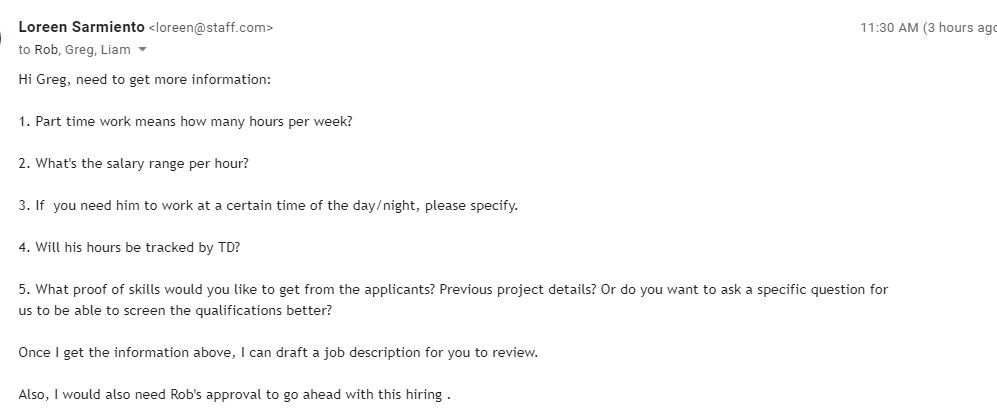
The example above is for the hiring of a ‘data scientist’.
We need to get the approval of Rob (the CEO) for the hire.
Creation of job description following this format:
JOB TITLE:
- Also indicate if part time, full time, office-based or remote.
- Short, clear and specific.
JOB SUMMARY :
- Two or three sentences about the position and the company.
- Tip: Include keywords in the summary that ideal candidates will likely search for when job hunting.
- It is a good idea to include a sentence about the importance of this position to the company.
- Who does the staff report to? Is there direct supervision or is this a position that must be self-regulating?
- Avoid gender-specific pronouns.
YOU WILL BE RESPONSIBLE FOR :
- Limit to 3 major responsibilities that the person is expected to do in this job
- For more complex positions it may be helpful to indicate the percentage of time for each task/responsibility.
TO BE A BEST MATCH FOR THIS JOB YOU NEED:
- Limit to 3-5 major skills/experience requirements that we require for this job
- You might also include prior knowledge or prior experience desired.
APPLICATION PROCESS:
- How would the applicants submit their application?
- What would you require them to submit – resume, cover letter, work portfolio (specify what kind)
- Put this note as a last statement: ONLY applications with answers to these questions {or to this test} will be considered for screening.
Use this as a closing section of every job description.
ABOUT OUR COMPANY:
Time Doctor is a time-tracking and productivity tool. Our software can be used by individuals or teams to track time for tasks as well as to monitor computer activity, by taking screenshots while working, monitoring keyboard and mouse activity, and tracking web app and website usage. We have a team of over 70 people working 100% remotely in 28 different countries. More about us can be found here:
https://www.timedoctor.com/about-us.html
https://www.linkedin.com/company/time-doctor
— Go back to outline —
2. Sourcing
Use an Applicant Tracking System (ATS)
What we did before:
- We were using a lot of spreadsheets in recording the information of applicants (names, phone numbers, addresses, etc).
- We used Dropbox to store their resumes, photos and portfolios so these can be sent to hiring managers for review.
- We used Skype extensively to contact applicants especially that they are located in different countries.
- Testing materials had to be emailed back and forth.
We realized that we were not very efficient in using our time by doing every hiring step ourselves.
What we’re doing today:
We invested in Breezy, an Applicant Tracking System (ATS) to hire great employees with less effort.
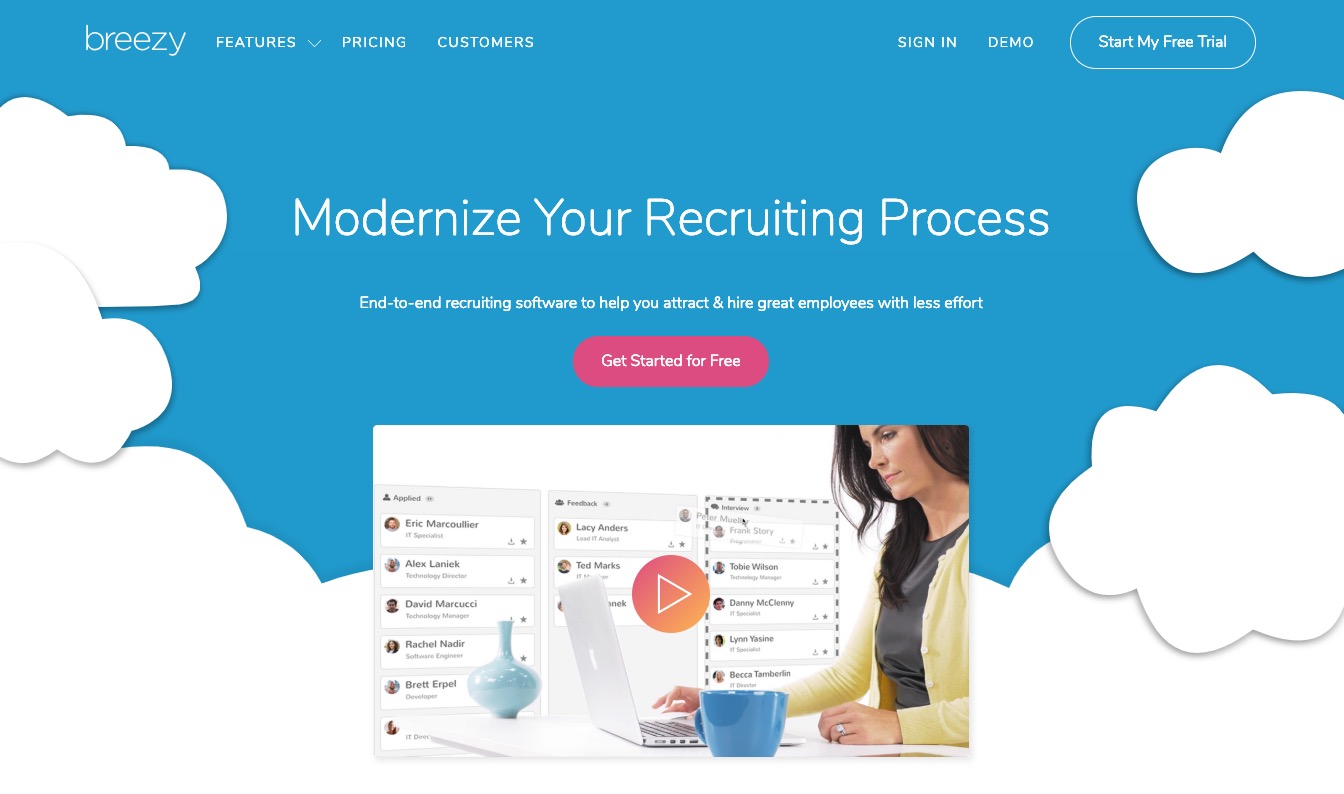
An ATS is software that organizes applications and creates profiles for each candidate. It also serves as a platform for applicants to know more about the company. The guide here provides an overview of applicant tracking systems.
It has a company portal that showcases who we are as a company, how we work and what we do as a team. This augments the Career page in our website.
External job site posting
Placement of job posts is crucial to finding many applications. Make sure it is targeted.
Since we are all working remote, we keep a list of job sites that can give us a high number of people who are good at working remotely. Being familiar with and able to enjoy remote working is a skill set, so among all other technical skills, this is an important requirement.
Remote.com, Upwork, Freelancer.com and Dynamite Jobs are just a few examples of sites where remote workers abound.
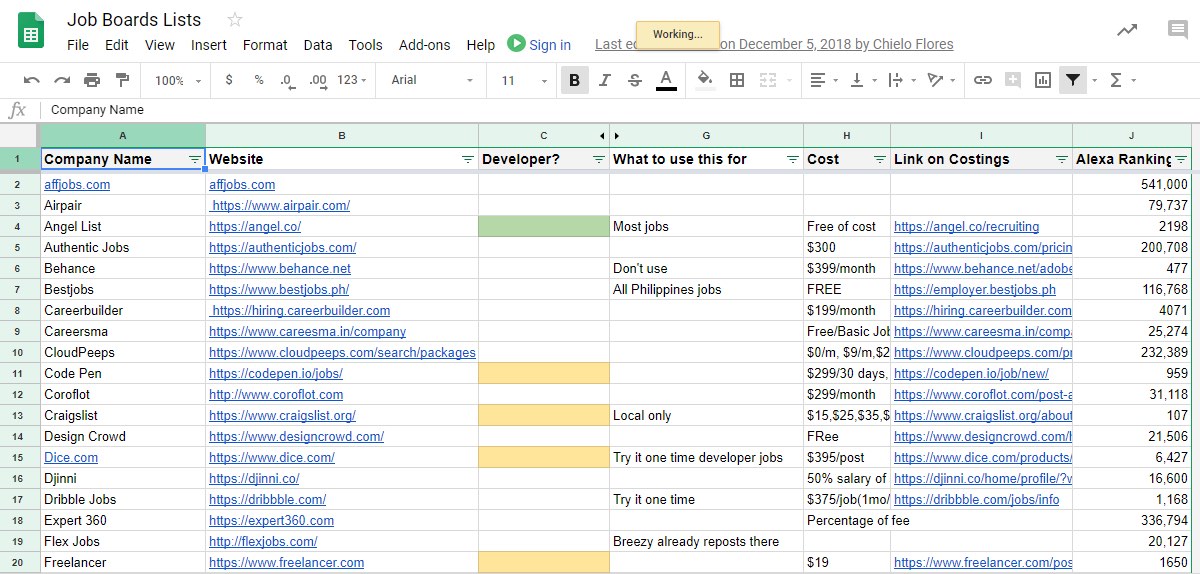
There are also job boards, forums and events that are industry-focused and where candidates with specialized skills are likely to spend time. It is good to post jobs in these channels.
A number offer free job posting, i.e. Stack Overflow is a targeted job site for developers. Writers can be found in Problogger Jobs. Dribbble hosts the background and portfolios of web designers.
Stack Overflow
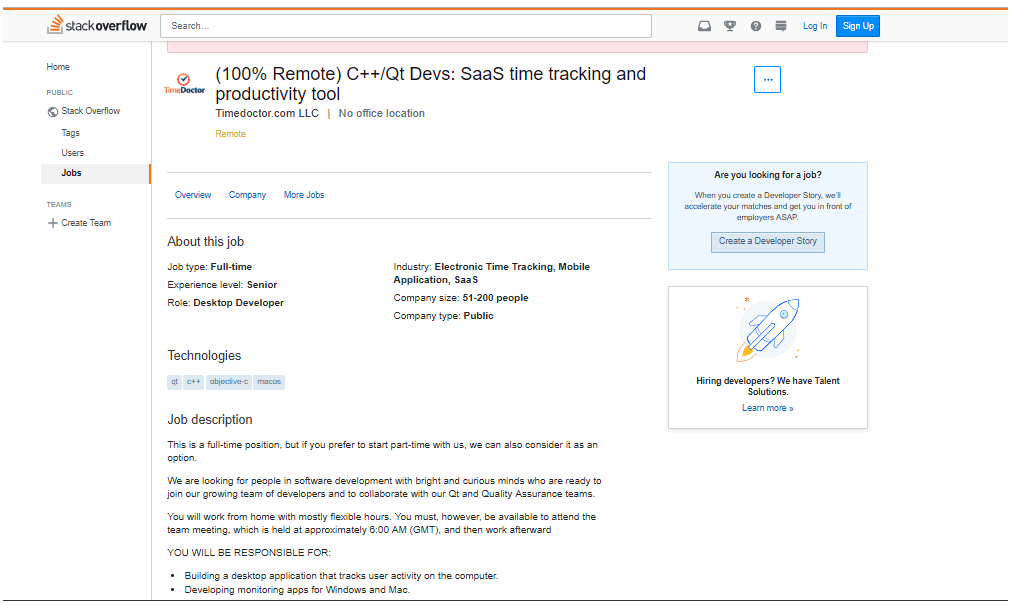
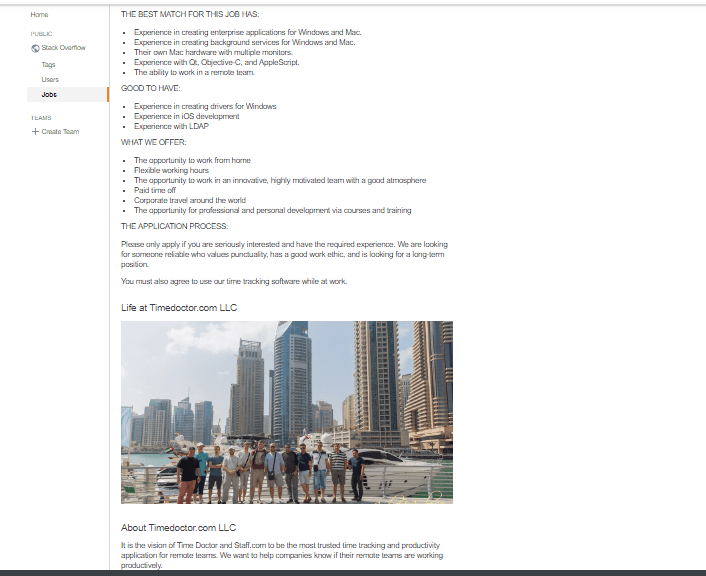
Upwork
For part time, project work and sometimes for full time, Upwork has been the job platform that has been our major source:
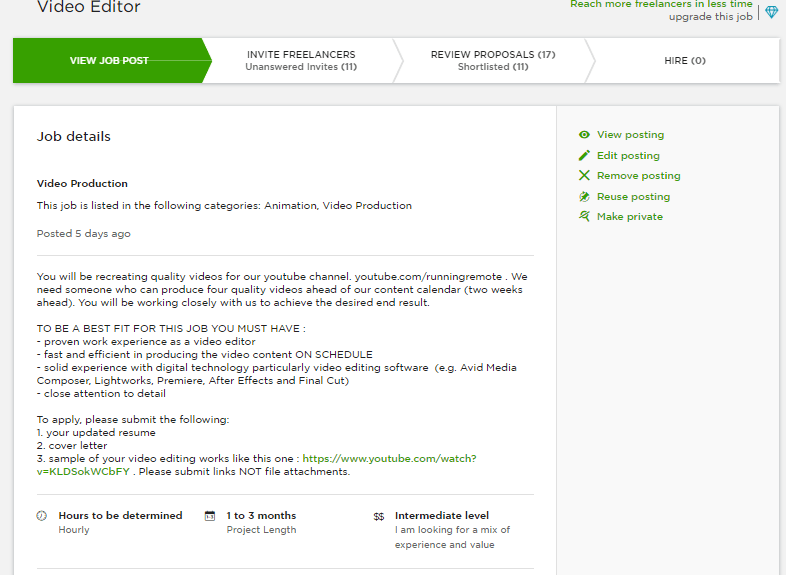
Outsourcely
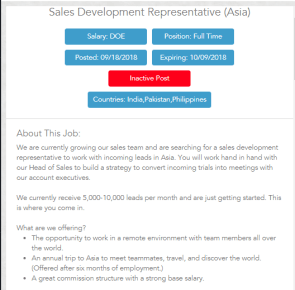
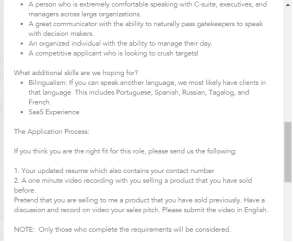
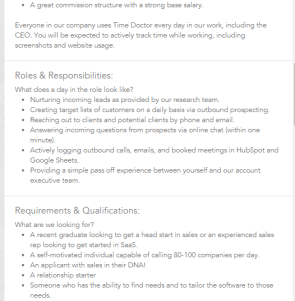
Active applicants are not the only ones that can be sourced. We realized that the highly skilled ones are most likely to be employed.
They’re what we call the passive candidates. And most likely they have their profiles in LinkedIn.
For our Sales positions, we were able to get some of the out of their current jobs to join us. It happened that though they are currently employed, they were just waiting for a job offer that may be better than the one they already have.
Referral system
We incentivize employee referrals.
Aside from being more familiar with our company, referred employees have quicker, less expensive hiring timelines and better retention rates than applicants sourced from other channels.
We announce a job hiring in the company’s Slack channel. The post includes the job link.
A referral bonus of $500 is given to an active staff whose referral is hired and remains to work in the company for at least 3 months.
— Go back to outline —
3. Tracking applications
Breezy, as our ATS, keeps track of all the activity that takes place around the candidate from the screening stage up to sending out a job offer. It’s the catch-all for all applicants that apply to the job ads we post in job boards.
Generally, we had filled in open jobs in more than 30 days. There was even one, the DevOps Senior role, that took us over 3 months. We did found a hire but he can only work part time. We still hired him as this was better than screening for months again.
So sometimes, for highly-skilled jobs, you can hire a part-time person at first (most of the very qualified ones have current employment) and hopefully, get them to migrate to full time role. You should keep the person super engaged with the company so that transition can happen in the near future.
— Go back to outline —
4. Screening applications

The goal of screening applications is to get a shortlist for the testing stage. The test passers will proceed to be interviewed by the recruiter and the hiring leader.
What hampered the screening process is that our recruitment team didn’t have a technical person. We are a software company but we didn’t have a recruiter who understands the technical skills of web developers, SEO specialists and web designers.
We tried tapping the services of external technical recruiters, on project basis, however we were not in control of their time and so we ended up waiting for results.
They had to spend time to know our business and team structures. And most of them were not oriented with the remote work set up. In short, we didn’t get much help with the external recruiters.
We looked into our HRM team. It knows the business and the team operations. Most of all, it has the heart for the company.
Our recruiters are adequate. They study the requirements of every role in the company and take time to collaborate closely with the hiring managers to understand the skills, qualities, and experience that the job requires to align our search with what he expects from a qualified applicant.
Validation process:
- Scan resumes for relevant skills and experience.
- Send a qualifying video question/test to the qualified applicants.
- Review test work by hiring manager.
- Schedule video call interview by hiring manager.
- Schedule second interview by recruiter to validate character, fitness to culture and corporate values.
- Identify top candidates.
- Background and reference check by HR.
- Consider a skills test to top candidates.
- Offer trial work to test passer(s).
BEFORE:
We just relied on scanning resumes. We didn’t get applicants to answer pre-qualifying questions. We also didn’t have a standard process to do background / reference check.
TODAY:
We send them questions that require them to answer on video to check on their communication skills.
Communication is very important for remote teams from different countries. We included video questions to hear how they speak and see how their workspace looks like.
OBSTACLE:
Although getting applicants to send videos of their test answers worked in some jobs, we realized that for technical positions, i.e. developers, it seems to be a turn off.
Those we identified as top candidates suddenly became unresponsive after we ask them to send video answers. So today, the use of video questions has become optional.
Disqualifiers
- Very high salary
- Not available to work during required work hours
- Does not like to use Time Doctor software to track work hours
- Wrong answers to application questions
- No experience in using the required skills
- Does not like to take a skills test
- Unresponsive or takes too long to respond to our communication
- No show in interview
- Does not like to send answer on video
- Agreement to use Time Doctor software
Note: Throughout the entire screening process, we make sure we stay in touch with the candidates , letting them know the status of their applications and keeping an archive of good candidates who can be potential hires in the future.
— Go back to outline —
5. Testing, assessment and interview
Testing and assessment
BEFORE:
We emailed tests and requested for portfolios. Back and forth, the communication was basically through emails.
We checked answers but then we realized that while written tests may prove technical prowess, how about work ethic and commitment? Proactivity and leadership? Commitment and efficiency?
In short, how do we get an initial glimpse of how they can be fit to our company culture?
TODAY:
The use of Breezy as our ATS has made communication easier. It is the common platform where we engage the applicants in submitting their answers and communicate with us.
Breezy also enables us to schedule interviews. But, we also use tools like Skype, Zoom or Hangout. In remote hiring, there are no personal appearances, therefore, a video call interview is the best option.
To align varying time zones, we use worldtimebuddy and synch schedules via Google Calendars, Calendly, ScheduleOnce or whatever calendar platform the hiring manager uses.
Job interviews aren’t always the most reliable indicator of a candidate’s ability to execute in a certain role. This is why, in addition to traditional approaches, modern employers need to use the best types of pre-employment assessments.
Types of tests
Scanning resumes and doing video calls with many applicants is time consuming. To identify the top shortlist, we use various testing tools.
a. Online technical skills test
For developers and other technical positions, we use HackerRank or Hundred5. They automate the scoring process and provide us the passers, the fails as well as those who ignored the test. This eliminated too much time screening resumes.
b. Paid skills test
This is internally created by hiring managers to test actual skills level needed for this job.
c. Live testing exercises
This is done during video call interviews.
Examples of assessment processes
Job: PHP Developer
- People apply via Breezy link
- Recruiter reviews the resumes and answers to application questions, filtering out any incorrect replies or people who did not answer the questions
- Recruiter also validates salary offers vs. budget
- Applicant takes HackerRank test
- Rosen marks the test
- Rosen does call video interviews of test passers
- Second video call interview by HRM
- Make offer for trial work of one month (probable 2 people)
Job: Contact Researcher
- Recruiter scans the resumes and see if they answer the question in their cover letter
- Recruiter validates salary and availability for full time
- Applicant takes a skills test created by hiring manager
- Carlo marks the test
- Carlo does video call interviews of test passers
- Make offer for trial work of one month
UI Designer
- Recruiter reviews resumes and design portfolio and eliminates anyone terrible
- Recruiter forwards resume and portfolio to Iulian
- Iulian checks portfolio and chooses 5-10 finalists based on their portfolio
- Recruiter checks rate and availability
- Recruiter sends a video question
- Iulian reviews video answers
- Iulian does video call interviews of final candidates
- Make offer for trial work of one month
Assessment strategies
“Project Work”
We realized that telling them to take a long test turns off shortlisted applicants, especially in technical positions.
The more qualified ones are usually already employed or busy working on projects that taking a test is a blocker to them. Most of them would like to be hired right away so they can actually prove their skills.
So, for tests that will last more than 2 hours, we use the term “ project work”. They’re likely to do it because most of them do projects anyway and it sounds like real work.
Finding Bottlenecks
We study data from our ATS, Breezy to check if our tests and questions are attracting a great number of applicants. If not, we are ready to change assessment strategy.
For example, in hiring an Electron Developer a very low percentage of candidates made it through the hiring manager’s interview. So we studied our data, through the reports in Breezy, our ATS of choice to find potential bottlenecks in our hiring pipeline.
We found out that a high percentage of applicants did not get back to us with answers to the video questions we posed (they submit a video recording of their answers).
We decided to eliminate the video question and instead, made them write about a project they initiated themselves. The answers started pouring in and then we had a good line up of interviews scheduled.
We inferred that developers may not like or have the time to do a video, so by looking at data, we can get to the bottom of the problem and revamp the screening process accordingly.
Character Check
Sometimes, hiring managers are so amazed at a candidate’s skills and the results of their test that they want to hire them right away. However, HRM cautions them against this because of adverse information resulting from the background check or an impression on behavior/character from an interview conducted.
Example: We reported to the hiring manager that a candidate for a developer job seemed to have a conflict-creating character. This was the impression we got from our interview and chats with him. When we ask him about the frequent jumps in jobs as indicated in his resume, he said when he is not satisfied with the rules at work, he can easily get frustrated and give up.
But because the hiring manager was impressed by his test work , work experience and skills, he went on to hire the candidate. But during his trial period, the same hiring manager noticed that conflict-creating character we were talking about.
The developer eventually resigned in less than 2 months of trial work because he said he was not allowed to work on other things and his suggestions are being rejected.
From thereon, HRM interview report/impressions run to the hiring manager as part of the process before deciding to hire.
Interviews

Leader’s interview
Aside from the usual skills validation questions, leaders assess the candidate’s level of proactivity in an interview.
For EVERY interview we add 2 questions to assess proactivity in their work. These questions are:
- Tell me about a time when you disagreed with your boss, what did you do about it?
- Tell me about a project you have done in your community, charity, sports, business or personal life that you started. It can be also a business you started, a community project, a charity, a sports project. It should not be in your job. You must have started it yourself. Tell me how you started it and why you started it. It is totally ok if the project failed or isn’t around any more. Just the fact that you started it is great.
We look for the following in the answers:
- Can they think of something? Give them some time and give them some ideas in case they can’t think of it. It’s ok for them to take some time to think of the answer.
- Does it sound like they started it or someone else started it? (looking for something that they started)
- Try and get an idea of how much effort they put into it (a lot of effort is good)
- It’s ok if the project failed. For example if they started a business and they put lots of energy into it and then it failed this is a GOOD thing and they passed these questions.
- Ask more details if you think they are making it up.
HR’s interview
After the Hiring Manager’s interview, the Recruiter engages the final candidates in another video call to find a culture fit and validate behavior and character.
As a line of questioning, we ask for specific scenarios that give us an insight into how they will live our four company values:
- Do they really enjoy working remotely and how do they plan to handle distractions and interruptions when working from home?
- How proactive and self-directed are they?
- Do they believe in constant learning to improve their skills?
- How will they show respect to workmates?
— Go back to outline —
6. Trial period
Hiring people who’s been in a corporate environment and now moving them to work remote with a team can be challenging. And even if they have been used to working remote, we wouldn’t really know how well they can adapt to the new job or team.
Final candidate(s) are asked to go through a trial period, say for two to four weeks. The tasks are real, something that the candidate will do alongside the people they would actually be working with if they had the job.
Doing the trial period allows us to quickly and efficiently assess whether there would be a productive relationship with the candidate; see how they think and work under pressure and whether they’re qualified for the role.
A trial period is a practical set-up because we may want to hire the right candidate but he or she may still be currently employed. We don’t advise them to leave their current jobs, but they can spend say 10 to 30 hours per week only on flexible time to focus on the tryout.
Of course, we pay them for this trial work. We set an hourly pay based on what we can pay them if they were hired.
— Go back to outline —
7. Onboarding
After sourcing, recruiting, interviewing and selecting the best candidate to go through the trial period, we are ready to bring them to come aboard.
The goal is to create a seamless transition from the recruiting process to the new job, even if this is the trial period yet. We believe that the first 60 days are a critical time in establishing a new staff’s success.
The onboarding process involves not only the HRM team but also the leaders. It’s essential for them to help them train and manage new staff effectively, while making the experience personal and transformative.
The process involves 3 parts:
First part: Onboarding during the first hour of work
This aims to put the candidate at ease and informed on his first day of work.

It is during this first hour that the leader makes clear the first week task list.
Examples
Manual software tester
- Day 1 – Orientation and Product training
- Day 2 – Exploratory testing of Desktop application
- Day 3 – Exploratory testing of Web app
- Day 4 – Exploratory testing of Web app
- Day 5 – Exploratory testing of Website
Sales Dev Rep
- Qualified appointment
- Inbound over 5 seats/employees
- Outbound over 10 seats/employees
- Attendance of a meeting with the Product specialist
Second part: Ongoing onboarding by leaders during the succeeding weeks
An ongoing onboarding process is very important to :
- Stay in touch with the candidate over time. We are deliberate in offering feedback and praise. The feedback mechanism is done through regular one-to-one chats and performance reviews. The candidates need to know what’s expected of them, how they stack up to work standards and what they can do to improve.
- Give an opportunity for a failing candidate to still improve. The regular chats will also enable the leader to offer support and come up with ways to help the candidate be back on good track.
- Help acclimatize the candidate to the company/team culture. We hope they will also choose us as the company they’d like to work for at the end of the trial period.
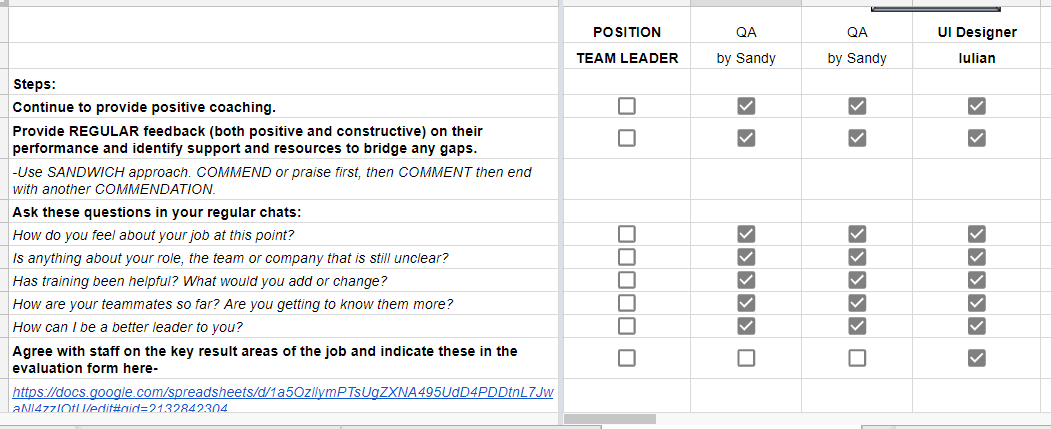
Third part: Onboarding after two months
This process is necessary for the leader to make an objective decision to hire officially the candidate or not.
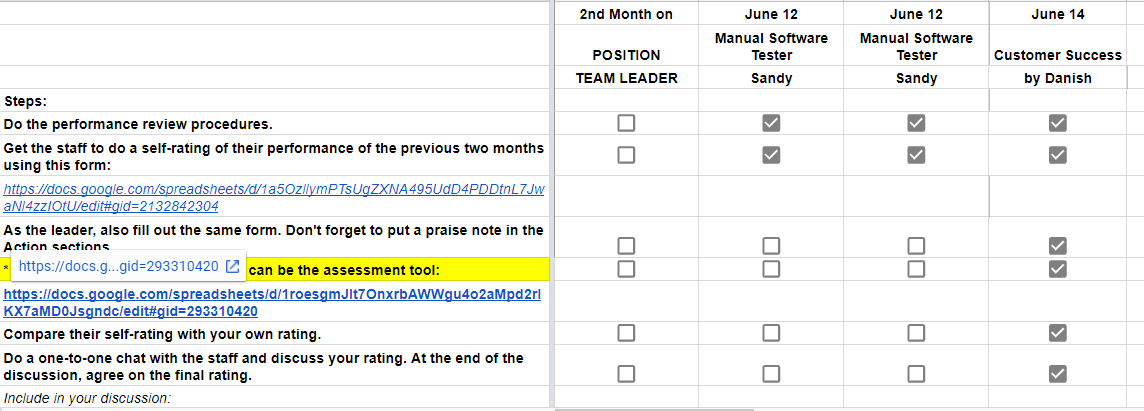
— Go back to outline —
8. Hiring
The trial period may involve 2-3 candidates doing actual work , however, if the job needs only one hire, the decision to choose only one of those on trial lies in the hands of the team leader.
Hiring principles of the company
We generally hire people for attitude and ability to learn rather than experience and skill (with some exceptions).
There are a lot of very successful and large companies that take this approach. This point might cause some debate but it is correct for most positions in the company.
We use tests and we don’t use resumes for an initial screen when recruiting (with few exceptions)
This is the same approach that Toggl uses by the way and I think it really works. We want to remove resumes from the process totally for most jobs and if we need to ask about their work history we can ask in some questions.
The resumes come in handy as a reference for interviews (so that we can see their job history in the Interview) and we do use resumes to check references.
The tests should exactly match the work the person will be doing on the job.
As close as possible to the actual work.
We have very high standards. If we don’t find someone we like we keep looking.
We are looking for people who match our values.
These are:
- Enjoy Working Remotely. How can I enjoy working remotely from wherever I am?
- Proactive and Self-driven. What else can I do that will help the business?
- Constantly Learning. How can I improve my skills? |
- Respect for Workmates. How can I show respect for all my workmates?
Team leader hiring standards: 4 C’s
1. Competency
Did the candidate show the necessary skills and experiences to successfully complete the tasks that needed to be performed? Consistency in attendance to work and team meetings.
2. Commitment
Is the candidate serious about working for the long term? Is this manifested through consistency in attending meetings and completing work on time?
3. Character
Is the candidate selfless, honest and truthful? Is the candidate a team player – willing and has the ability to be harmonious with the leader and other team members?
4. Culture fit
Did the candidate easily adapt to the company’s culture and values?
— Go back to outline —
9. Final onboarding
This is a completion of the onboarding process that started during the candidate’s trial period. Important steps added are:
- Discussion of the Team Handbook (this contains how a remote staff should behave as part of the team, what is expected of him as a productive team member and the team process that he/she is involved in)
- Discussion of the HR Handbook (more information about HR policies and procedures)
- More information gathering about the new staff
- Issuance of regular contract
- We stay in touch with new hires especially during their first year of work.
— Go back to outline —
Hiring remote staff is a smart move to attract top talents beyond the one location. But it also requires smart strategies in recruiting so that the right talent is hired and placed effectively.
When properly done, expect to have remote teams who can experience better work-life-balance and job satisfaction, which ultimately spells loyalty, retention and less bottom-line costs.

Andy is a technology & marketing leader who has delivered award-winning and world-first experiences.


